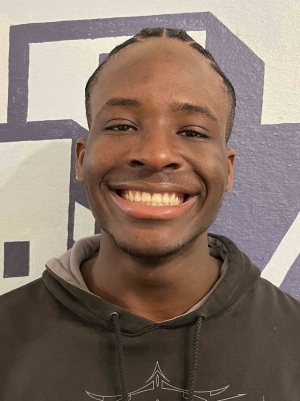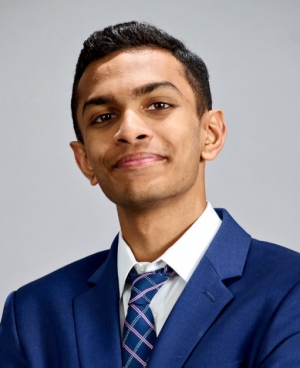This past year, the Undergraduate Community Initiative (UCI) expanded its programming with two new undergraduate fellowships stewarded by the Center for the Core Curriculum. Both built upon the foundation of the Core classroom, which fosters community even as students debate and work through ideas that might be very different from their own.
The Practices in Community Building Fellowship focused students on developing projects that aim to bring people together on campus. Central to that was the collaborative aspect; 25 fellows worked in small groups based on their areas of interest (for example, service, storytelling or the arts) to hone their project ideas and begin bringing them to life. The entire cohort also met regularly to hear from guest speakers and discuss assigned Core-related readings, while carving out time individually for volunteerism and reflection.
The Listening Tables Core Student Fellowship, meanwhile, was undertaken in partnership with the Trust Collaboratory and emphasized how students engage with others. Students — who were put in one of two groups — explored ways for people to navigate discussions about potentially divisive topics with mutual empathy and respect, and documented what it’s like to be part of difficult dialogues.
The fellows group received training in conflict resolution, then led small-group conversations where participants representing many perspectives could talk with one another about difficult and polarizing issues. The ambassadors group used a research method known as “photo voice,” where participants took photographs to capture their experiences at the Listening Tables and in other dialogues, then analyzed their images in order to share their insights with others.
We caught up with CC students who participated in each fellowship; their answers have been edited for length and clarity.

What drew you to this fellowship?
I’ve long been involved in organizations that support both the Columbia community and our neighbors in Harlem and Morningside Heights — programs like Community Impact, which addresses local needs, and Active Minds, which works to destigmatize mental health. But I wanted to move beyond service and into something deeper — a space to wrestle with the complexity of building community across lines of difference. I was looking for a place where I didn’t have to perform or filter myself to fit into an institutional mold, but could instead be honest, vulnerable and challenged. I knew the conversations would be difficult — and that’s exactly why I wanted in.
Tell me about your group’s project.
Our project was born out of a moment of collective tension on campus, one that exposed how fragmented and fearful our community can feel when conflict arises. We wanted to create a visual and narrative archive that would bring together people from all sides of recent campus events: Palestinian and Jewish students, protest monitors, bystanders, staff, faculty, even members of the wider Harlem and other New York City communities. The idea was to photograph participants anonymously, often alongside something meaningful to them — a space, an object, a piece of writing — while conducting brief interviews about how they’d been impacted.
The aim wasn’t to take a political stance but [instead] to reclaim the humanity often lost in polarized narratives. This was about holding space for complexity, for the emotional and personal layers behind the headlines. We hope to share the work publicly through postering, a small exhibition and an online platform that allows people to engage with the project on their own time and terms. It’s still in motion, but I’m excited about its potential to disrupt the silence and create more reflective, empathetic dialogue on campus.
What were some highlights of your fellowship experience?
One major highlight was the classroom space itself. I don’t think I’ve ever been in a setting at Columbia that felt so open, so brave. It wasn’t that we agreed with each other — far from it. But we were encouraged to sit with disagreement, to name our discomfort and to stay in the conversation even when it got hard. I said things in that room I’d never said out loud, not because they were extreme, but because they were honest. That kind of space is rare, especially in an academic environment where there’s so much social pressure to present yourself a certain way.
Another highlight was being part of a cohort that genuinely cared. We weren’t just checking boxes for a fellowship; we were showing up, week after week, with real stakes. I felt seen and supported, even when I was struggling to articulate something messy or contradictory. It reminded me that community isn’t about always being in sync; it’s also about committing to stay connected, even when things get uncomfortable.
Any big takeaways?
One of the biggest lessons I’m walking away with is that community isn’t something that just happens — it’s something we have to build, again and again, through intentional habits. I’ve realized how much of Columbia’s culture discourages vulnerability and how vital it is to carve out spaces where people can speak freely without fear of judgment or consequence.
Another takeaway is about the limits of reflection without action. Our classroom conversations were powerful, but they often felt confined. Once we left the room, it was easy to slip back into the old rhythms of silence, caution, self-protection. That’s why the project component mattered so much to me. It’s an attempt to break that pattern and bring some of the honesty we found in the fellowship into the public sphere. If we want to change how people relate to one another on this campus, we have to take risks not just in thought, but also in practice.

What drew you to this fellowship?
I went to an extremely progressive liberal arts high school, and opposing political views were often met with skepticism and even hostility. Yet over my four years there, a friend and I were able to transform the campus culture significantly through panels, constructive conversations and administrative reform (similar to what we’re doing now at the Trust Collaboratory).
At Columbia, I’ve been involved with several dialogue-based initiatives, like BridgeUSA and the Listening Tables, even before the fellowship. So I felt as though the fellowship would help to hone my skills in conflict resolution and trust-building, giving me the resources necessary to further advance my mission of fostering constructive dialogue and unity on campus.
You were in the “fellows” group; tell me about leading a Listening Table.
It was an incredibly transformative experience. [To have] the creative liberty of tinkering with the format [made it] super engaging and challenging.
I hosted a table in VanAm Quad; I first put everyone into smaller groups to discuss the relevant issues (immigration, protests, Middle East conflict, etc.) and then brought everyone back together for a group-wide discussion. I really believe that having a smaller, icebreaker-esque first part where you can share your thoughts in a more intimate space gives you the confidence to then “scale up” that conversation to a larger group. It was a resounding success, as people felt much more encouraged and comfortable being vulnerable since they’d almost “practiced” engaging in dialogue already.
What were your takeaways from the experience?
One, I think the culture on campus has shifted in a monumental way. When I first arrived, people were still reeling from the aftermath of last year and were a bit hesitant to engage with the other side out of fear of retribution or social ostracization. However, now, 150-plus Listening Tables later, there has been a palpable vibe shift. People seem to be leaning into the difficult conversations both in and out of our Trust Collaboratory/Bridge USA settings. Whether it be huge attendance at one of our events, every Listening Table in John Jay or Van Am Quad being packed or the occasional passerby having a dynamic exchange of clashing ideas, the work is already showing and is only going to get better next year!
Secondly, the work of the Core has added a depth to campus conversations that I never thought possible. The Core has long been a staple of the College’s curriculum, yet we often find ourselves contemplating its contemporary value. An initiative like this really augments that idea on a transformative scale. Whether it be analyzing the exchange of democratic dialogues in Plato’s Symposium or the embodied theatrics of King Lear, these deep-seeded questions surrounding human behavior, love, justice and so on really do translate to how we understand each other in the context of current political conflicts and the news.
A class like Lit Hum or CC is a perfect microcosm of the fellowship and the Listening Tables’ mission: a sit-down with people who have dramatically different ideas and who are passionate yet are intellectually humble and ready to learn from one another. Seeing how what we’re learning in the classroom intersects with our mission to substantively change our community and the world for the better has been one of the most intellectually fulfilling experiences of my time at Columbia so far.

What drew you to this fellowship?
In high school I was on several committees, such as the DEI Board and the Associated Student Body, which were spaces to bring up issues within our community. They were also places where my voice could be heard, and we could implement solutions to problems that arose on campus. However, when I came to the College, I felt that I lost that aspect of community. Although I was asked for my opinions on academic texts every day, it seemed there was no avenue for my voice to be heard on campus. When I heard about the Listening Tables, I knew it was the exact program I was looking for to bridge the dissonance I felt between myself and the University. It was a space to connect with my peers.
You were in the ambassadors group; tell me about “photo voice.”
I didn’t know what it was before becoming an ambassador but I am so grateful for the support and education I received about it. During our [fellowship] sessions, we learned about photo voice as a research method and the basics of photography to improve our pictures. Having a space where my peers and I could comment on each other’s work was essential, and I am sure that through our collaboration, my photo voice improved for the better.
What did you focus on in your images?
At first my partner, Imaan, and I tried approaching students whom we didn’t know, but due to the climate surrounding media and reporters, many people did not want to open up to us. So we focused on shooting ourselves and our close friends. If we did photograph a stranger, it was usually more than one person, and they were in a wide setting where their faces were not visible within a crowd.
Any big takeaways from your experience?
The idea of media presence versus private sphere. Often the media shows a fractured view of Columbia, and in my ignorance, I started to believe it, too. However, by purposefully examining how my peers and I engage in dialogue with one another, I learned there are two sides to every story. And I got to experience both of them. I learned that I don’t have to accept the narrative I was being told — I can write my own.